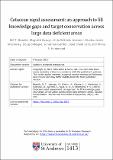Files in this item
Cetacean rapid assessment : an approach to fill knowledge gaps and target conservation across large data deficient areas
Item metadata
| dc.contributor.author | Braulik, Gillian T. | |
| dc.contributor.author | Kasuga, Magreth | |
| dc.contributor.author | Wittich, Anja | |
| dc.contributor.author | Kiszka, Jeremy J | |
| dc.contributor.author | MacAulay, Jamie | |
| dc.contributor.author | Gillespie, Doug | |
| dc.contributor.author | Gordon, Jonathan | |
| dc.contributor.author | Said, Said Shaib | |
| dc.contributor.author | Hammond, Philip S. | |
| dc.date.accessioned | 2018-10-04T23:46:54Z | |
| dc.date.available | 2018-10-04T23:46:54Z | |
| dc.date.issued | 2018-02 | |
| dc.identifier | 250475158 | |
| dc.identifier | 07b8c99c-5efe-4adc-a84c-9045f00ee461 | |
| dc.identifier | 85030651277 | |
| dc.identifier | 000425121900022 | |
| dc.identifier.citation | Braulik , G T , Kasuga , M , Wittich , A , Kiszka , J J , MacAulay , J , Gillespie , D , Gordon , J , Said , S S & Hammond , P S 2018 , ' Cetacean rapid assessment : an approach to fill knowledge gaps and target conservation across large data deficient areas ' , Aquatic Conservation: Marine and Freshwater Ecosystems , vol. 28 , no. 1 , pp. 216-230 . https://doi.org/10.1002/aqc.2833 | en |
| dc.identifier.issn | 1052-7613 | |
| dc.identifier.other | ORCID: /0000-0002-2381-8302/work/47531625 | |
| dc.identifier.other | ORCID: /0000-0001-9628-157X/work/60427054 | |
| dc.identifier.other | ORCID: /0000-0001-8919-4187/work/80257766 | |
| dc.identifier.uri | https://hdl.handle.net/10023/16150 | |
| dc.description | The work was funded by the Pew Marine Fellows Program and WCS. | en |
| dc.description.abstract | 1. Many species and populations of marine megafauna are undergoing substantial declines, while many are also very poorly understood. Even basic information on species presence is unknown for tens of thousands of kilometres of coastline, particularly in the developing world, which is a major hurdle to their conservation. 2. Rapid ecological assessment is a valuable tool used to identify and prioritize areas for conservation; however, this approach has never been clearly applied to marine cetaceans. Here a rapid assessment protocol is outlined that will generate broad‐scale, quantitative, baseline data on cetacean communities and potential threats, that can be conducted rapidly and cost-effectively across whole countries, or regions. 3. The rapid assessment was conducted in Tanzania, East Africa, and integrated collection of data on cetaceans from visual, acoustic, and interview surveys with existing information from multiple sources, to provide low resolution data on cetacean community relative abundance, diversity, and threats. Four principal threats were evaluated and compared spatially using a qualitative scale: cetacean mortality in fishing gear (particularly gillnets); cetacean hunting, consumption or use by humans; shipping related collision risk and noise disturbance; and dynamite fishing. 4. Ninety‐one groups of 11 species of marine mammal were detected during field surveys. Potentially the most important area for cetaceans was the Pemba Channel, a deep, high‐current waterway between Pemba Island and mainland Africa, where by far the highest relative cetacean diversity and high relative abundance were recorded, but which is also subject to threats from fishing. 5. A rapid assessment approach can be applied in data deficient areas to quickly provide information on cetaceans that can be used by governments and managers for marine spatial planning, management of developments, and to target research activities into the most important locations. | |
| dc.format.extent | 1249309 | |
| dc.language.iso | eng | |
| dc.relation.ispartof | Aquatic Conservation: Marine and Freshwater Ecosystems | en |
| dc.subject | Cetaceans | en |
| dc.subject | Distribution | en |
| dc.subject | Environmental impact assessement | en |
| dc.subject | Management | en |
| dc.subject | Marine spatial planning | en |
| dc.subject | Rapid assessment | en |
| dc.subject | Tanzania | en |
| dc.subject | GE Environmental Sciences | en |
| dc.subject | QH301 Biology | en |
| dc.subject | SH Aquaculture. Fisheries. Angling | en |
| dc.subject | NDAS | en |
| dc.subject | SDG 14 - Life Below Water | en |
| dc.subject.lcc | GE | en |
| dc.subject.lcc | QH301 | en |
| dc.subject.lcc | SH | en |
| dc.title | Cetacean rapid assessment : an approach to fill knowledge gaps and target conservation across large data deficient areas | en |
| dc.type | Journal article | en |
| dc.contributor.institution | University of St Andrews.School of Biology | en |
| dc.contributor.institution | University of St Andrews.Scottish Oceans Institute | en |
| dc.contributor.institution | University of St Andrews.Sea Mammal Research Unit | en |
| dc.contributor.institution | University of St Andrews.Marine Alliance for Science & Technology Scotland | en |
| dc.contributor.institution | University of St Andrews.Sound Tags Group | en |
| dc.contributor.institution | University of St Andrews.Bioacoustics group | en |
| dc.contributor.institution | University of St Andrews.Centre for Research into Ecological & Environmental Modelling | en |
| dc.identifier.doi | 10.1002/aqc.2833 | |
| dc.description.status | Peer reviewed | en |
This item appears in the following Collection(s)
Items in the St Andrews Research Repository are protected by copyright, with all rights reserved, unless otherwise indicated.

